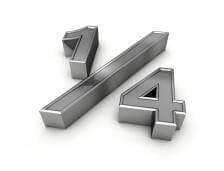How to Compare Fractions
Is 4/7 greater than 5/9? Is 3/13 less than 11/45? What’s the best way to compare fractions so that you can line them up in ascending or descending order? Keep on reading to find out!

Why Are Some Fractions Hard to Compare?
Why is it easy to compare fractions like 1/4 and 1/2 but hard to compare fractions like 4/7 and 5/9? For one thing, you have an intuitive understanding of what fractions like 1/4 and 1/2 look like relative to each other. Whether you like to picture pizzas, pies, or something else, you know that 1/2 takes up twice as much area as 1/4. But that intuitive understanding of relative size just doesn’t exist when you’re thinking about fractions like 4/7 and 5/9. Why? Well, for one thing, we don’t deal with fractions like 4/7 and 5/9 very often. So although we might be able to quickly figure out that they both represent numbers that are a little bigger than 1/2, we don’t have a good feeling for exactly how much bigger.
I’m not sure if this is how the brain actually works, but it seems like we have the ability to rewrite simple and familiar fractions in terms of a common denominator so that we can easily compare them. And it seems like we do all of this pretty much automatically without really thinking about it. For example, it seems as if the brain intuitively rewrites the fractions 1/4 and 1/2 in terms of their common denominator 4 and quickly recognize that 1/2 is equivalent to 2/4 and therefore twice as large as 1/4. Whether or not this process really is semi-automatic for common fractions, when it comes to less familiar fractions like 4/7 and 5/9, this process is definitely not automatic. Which means we have to do a bit of work.
Method 1: Use a Common Denominator
And that brings us to our first method for comparing fractions: writing them in terms of a common denominator. Once two or more fractions are rewritten in terms of a common denominator, all you have to do to compare them is look at their numerators. For example, we can compare 4/7 and 5/9 by writing them in terms of their common denominator 63. In this case, 63 happens to be their lowest common denominator, but this method will work for any choice of common denominator. We can rewrite 4/7 in terms of the denominator 63 by multiplying its top and bottom by 9 to get 36/63. Similarly, we can write 5/9 in terms of the denominator 63 by multiplying its top and bottom by 7 to get 35/63.
So the fraction 4/7 is equivalent to 36/63, and the fraction 5/9 is equivalent to 35/63. What does that tell us? Well, since we now have an apples-to-apples comparison, we immediately see that the fraction 4/7 is greater than 5/9. How about the fractions 3/13 and 11/45—which is larger? To find out, let’s write them in terms of the common denominator 585. Multiplying the top and bottom of 3/13 by 45, we find that it’s equivalent to the fraction 135/585. And multiplying the top and bottom of 11/45 by 13, we find that it’s equivalent to the fraction 143/585. Which means that 11/45 is a big bigger than 3/13.
Method 2: Convert Fractions to Decimals
In truth, doing all of this rewriting of fractions in terms of a common denominator can be kind of a pain. It’s not exactly hard to do, but it takes time…and it’s often not the fastest way to compare fractions. Which brings us to the second method for comparing fractions. Instead of rewriting them in terms of a common denominator, the fastest way to compare fractions is to convert them into decimal numbers. After you do that, you can then put the fractions you’re comparing in ascending or descending order simply by ordering them in terms of their decimal representations.
How do you rewrite a fraction as a decimal number? It couldn’t be easier. As we learned way back when we talked about the connection between fractions and division, all you have to do is divide the numerator of the fraction by its denominator (this is often easiest and quickest to do with the help of a calculator). So the fraction 4/7 = 0.571… and the fraction 5/9 is equal to 0.555… (we learned about this special case in the episode on how to convert repeating decimals into fractions). Just as we found earlier using the common denominator method, the fact that the decimal 0.571… is larger than 0.555… tells us that the fraction 4/7 is greater than 5/9.
Believe it or not, that’s all there is to comparing fractions. Whether you prefer to rewrite them in terms of a common denominator and compare their numerators or simply convert them into easily comparable decimal numbers, writing fractions in ascending or descending order is a relatively straightforward task.
Wrap Up

Until next time, this is Jason Marshall with The Math Dude’s Quick and Dirty Tips to Make Math Easier. Thanks for reading, math fans!


